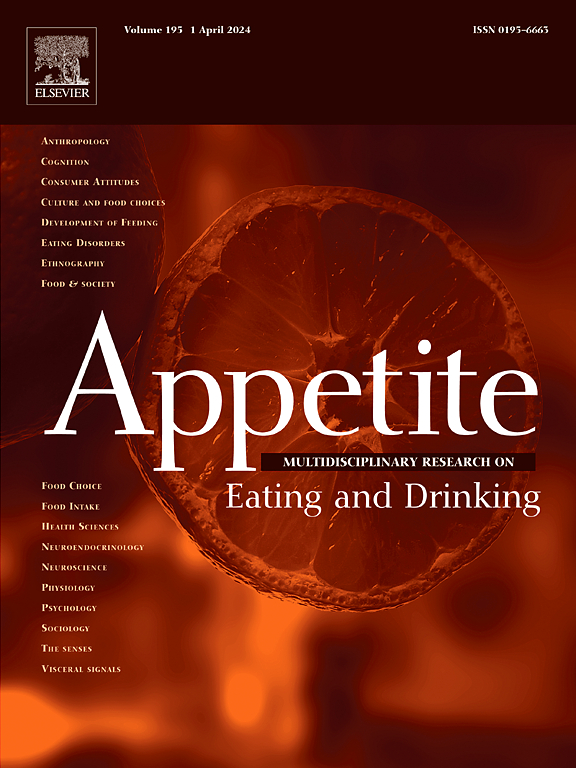手秤是指导和估计食物份量的合适工具吗?对自由生活的成年人的评价。
IF 3.8
2区 医学
Q1 BEHAVIORAL SCIENCES
引用次数: 0
摘要
手量表,它使用手的数量(例如,拳头和手掌)来估计份量,在实践中被广泛使用。然而,关于它在自由生活环境中的适当性的证据有限。本研究旨在检验实际食物消耗量(克/餐)与用于估算食物分量的自述手数之间的关系,并开发和评估基于自述手数估算每餐食物消耗量的模型。在这项横断面研究中,1081名年龄在20-69岁之间的自由生活的日本成年人完成了一项为期4天的称重饮食记录,记录了早餐、午餐和晚餐(总共12,148顿饭)的食物消耗量(以克为单位)以及用来估计份量的手的数量(谷物食物和水果用拳头,蛋白质食物用手掌,蔬菜用大把)。实际食物消耗量与自我报告的手数之间的相关性进行了研究。采用随机1:1分样本方法开发和评估了估算食物消耗的模型,该模型结合了自我报告的手数和参与者特征。实际食物消耗量(克/餐)与自我报告的手数之间的Spearman相关系数为谷物食品0.59,水果0.85,蛋白质食品0.72,蔬菜0.76。在开发组中,使用自我报告的手数的模型解释了每餐食物消耗差异的34%-65%。在评估组中,尽管存在广泛的一致性限制,但实际和模型估计的食物消费量具有可比性(平均差异:-2.5至-0.3克/餐),具有中等至强相关性(斯皮尔曼相关系数:0.61-0.75)。总之,手秤可以作为一个适当的分量估计工具。需要进一步的研究来评估它在不同食物和人群中的适用性。本文章由计算机程序翻译,如有差异,请以英文原文为准。
Is the hand scale an appropriate tool for guiding and estimating food portions? An evaluation among free-living adults
The hand scale, which uses the number of hands (e.g., fists and palms) to estimate portion size, is widely used in practice. However, evidence regarding its appropriateness in free-living settings is limited. This study aimed to examine the relationship between actual food consumption (g/meal) and the self-reported number of hands used for estimating portion size and to develop and evaluate models for estimating food consumption per meal based on the self-reported number of hands. In this cross-sectional study, 1081 free-living Japanese adults aged 20–69 years completed a 4-day weighed dietary record, documenting food consumption in grams alongside the number of hands used to estimate portion size (fists for grain foods and fruits, palms for protein foods, and handfuls for vegetables) at breakfast, lunch, and dinner (12,148 meals in total). Correlations between the actual food consumption and the self-reported number of hands were examined. Models for estimating food consumption, incorporating the self-reported number of hands and participant characteristics, were developed and evaluated using a randomized 1:1 split-sample approach. Spearman correlation coefficients between the actual food consumption (g/meal) and self-reported number of hands were 0.59 for grain foods, 0.85 for fruits, 0.72 for protein foods, and 0.76 for vegetables. In the development group, models using the self-reported number of hands explained 34 %–65 % of the variance in food consumption per meal. In the evaluation group, despite wide limits of agreement, actual and model-estimated food consumptions were comparable (mean difference: −2.5 to −0.3 g/meal), with moderate to strong correlations (Spearman correlation coefficient: 0.61–0.75). In conclusion, the hand scale can serve as an appropriate portion size estimation tool. Further research is warranted to evaluate its applicability across different foods and populations.
求助全文
通过发布文献求助,成功后即可免费获取论文全文。
去求助
来源期刊

Appetite
医学-行为科学
CiteScore
9.10
自引率
11.10%
发文量
566
审稿时长
13.4 weeks
期刊介绍:
Appetite is an international research journal specializing in cultural, social, psychological, sensory and physiological influences on the selection and intake of foods and drinks. It covers normal and disordered eating and drinking and welcomes studies of both human and non-human animal behaviour toward food. Appetite publishes research reports, reviews and commentaries. Thematic special issues appear regularly. From time to time the journal carries abstracts from professional meetings. Submissions to Appetite are expected to be based primarily on observations directly related to the selection and intake of foods and drinks; papers that are primarily focused on topics such as nutrition or obesity will not be considered unless they specifically make a novel scientific contribution to the understanding of appetite in line with the journal's aims and scope.
 求助内容:
求助内容: 应助结果提醒方式:
应助结果提醒方式:


